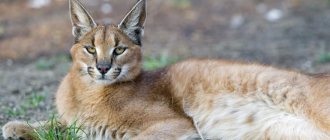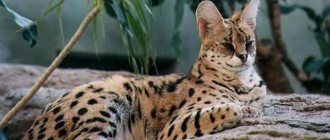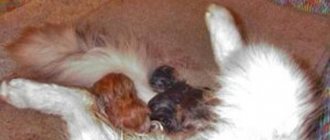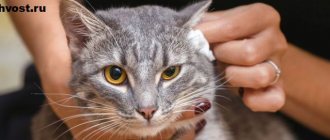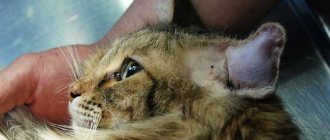Description and origin of the species
The name "caracal" was proposed by the French naturalist Georges Buffon in 1761, and comes from the Turkish "kara-kulak", which literally translates to "cat with black ears". The Greeks and Romans called the caracal a lynx, but today the name "lynx" belongs to a different genus. However, the animal is still often called a lynx.
The first scientific description of the species was made by the German naturalist Johann von Schreber in 1776 from the skin of an animal from the Cape of Good Hope. The animal received the scientific name Felis caracal. In 1846, British zoologist John Edward Gray separated the predator into a separate genus, Caracal, and changed the scientific name of the species to Caracal caracal. The animal belongs to the Feline family and the subfamily Small cats (Felinae).
Genetically, the caracal's closest relative is the African golden cat, another member of the Caracal genus. Their common ancestor separated from the common genetic line with the serval about 2 million years ago.
What does a caracal look like?
The caracal is a medium-sized wild cat. It is distinguished by an elongated muscular body, strong build, short muzzle, long powerful legs, and ears with black tassels. The height of the animal at the withers reaches 40-50 cm. The body length of males is on average 78-108 cm, plus a tail 21-34 cm long. Females are inferior in size to males: body length with head varies from 71 to 102 cm, with a tail 18 cm long. -31 cm. Males weigh from 7.2 to 19 kg, females are slightly smaller - from 7 to 15.9 kg.
On the ears of the caracal, recognizable black tassels up to 4.5 cm long are visible. With age, when the animal ages, the tassels may drop down. The animal has a narrow eye shape. Lowering the upper eyelid slightly helps protect the eyes from bright sunlight. On the muzzle there are black stripes from the corners of the eyes along the nose to the mouth, 3 dark stripes also cross the forehead and there are small specks of white fur near the eyes and mouth of the animal.
The caracal has no spots on its skin, the color is uniform and varies from red to reddish. The fur on the belly and back of the limbs is noticeably lighter. Very rarely, but there are black caracals - melanistic animals. The short and dense coat becomes coarser in summer and softer in winter due to the longer and denser undercoat in winter. In winter, the coat is longer - the length of the guard hair is about 3 cm in winter, and shortens to 2 cm in summer.
General characteristics and description of Caracal cats
The standard establishes the following characteristics of a cat's doodle:
- the body has a length from 60 to 85 cm, the tail from 23 to 35 cm. The weight of an adult is 10-20 kg;
- representatives have a graceful and strong body, quite muscular;
- The ears, pointed with tassels at the ends, have a narrow and long shape. Located at a great distance from each other. The color of the ears is black on both sides;
- the fur is short, but thick and slightly hard;
- almond-shaped eyes have a yellow-brown tint. A black stripe is visible around the eyes;
- paws are large and of medium length. At the bottom there is a brush made of hard hair, which helps the animals move along the sand;
- the head is small, slightly extended forward and covered with small spots;
- the tail is long and very mobile.
Shorthair cats: list of popular breeds
The color of caracal cats is similar to the North American puma. At the top, the fur can range from sandy to red-brown. There are white hairs below. Black stripes are visible on the sides of the head.
Note! In rare cases, there are black breeds called melanistic caracals.
Caracal and lynx
The caracal is often confused with the lynx. Outwardly, these animals are similar, both have a strong muscular body and pointed ears with tassels. The caracal is slightly smaller in size than the lynx, plus there is a difference in color - the lynx has grayish fur with dark spots, while the caracal has a uniform color without spots or stripes.
The difference between a caracal and a serval and a puma
In color, the caracal resembles a puma - the same uniform red or reddish coat color with lighter fur below. In terms of physique, the caracal is very similar to the African golden cat, but it has darker fur and no ear tufts.
Besides the African golden cat, the other close relative of the caracal is the serval. The serval differs from the caracal in its spotted color, larger ears without tufts, and much longer limbs and tail.
Description and standards of caracal
Above we said that there are 9 subspecies of caracal, although a person far from botany or felinology is unlikely to notice the difference from photographs.
Any steppe lynx is very large and tall. You can’t call her massive: her natural grace cannot be hidden, her heaviness does not catch the eye.
The elongated head is crowned with elongated narrow ears with the most charming tassels at the tips. There is a decent distance between the ears and they stand strictly vertical. On the back of the ears the skin is either flat black or gray.
The body looks lean and short. The tail is shorter than half the body. The graceful caracal moves on high, lean limbs. The paws are massive and large.
The color of the coat is beautiful, reminiscent of ocher mixed with sand. The villi are short and reddish. The fur on the belly and chest is longer. Yellow stripes under the eyes. There are no differences in color between males and females.
Dimensions and weight of caracals
The tall caracal cat reaches half a meter at the withers in adulthood. Pretty solid! The weight of cats reaches 15-21 kg. The weight of females is less than that of males. If such a pet sits on his lap, the owner will immediately feel every kilogram of the handsome man.
Caracal hybrids
Several breeders in Russia, Ukraine and the USA have bred and continue to breed caracal-domestic cat hybrids. Moreover, in the USA the Abyssinian cat is used.
global $ads_google; //data-ad-slot=”2475549904″ $ads_google = empty($ads_google) ? false : true; ?> if ($ads_google == false) {?>
$ads_google = true; ?> } ?>
The experimental breed was named caracat (cara(cal)+cat), which indicates its origin. The first generation hybrid is the most difficult to breed, because the male caracal does not accept representatives of another species for the purpose of reproduction. But breeders are persistent; today there are cats in the world that look like caracals, with an affectionate character and smaller dimensions.
For some reason, dogs don’t perceive Carket as a cat. For them, this is a creature equivalent to them, and relationships are built on the dog-dog principle
Another hybrid is the servical, or ser-caracal. In this case, breeders took a male from a serval and a female from a caracal. The cat's appearance resembles a serval, and its ears come from Caracal blood. This is a completely new breed, a pure experiment.
Where does he live?
Most of the caracal population lives in Africa. Predators are widespread south of the Sahara, but are practically absent in the north. In Asia, the animal lives on the Arabian Peninsula (Jordan, Saudi Arabia, Oman, Yemen), the Middle East (Israel, Turkey, Libya, Syria), Central Asia (Iran, Turkmenistan, Uzbekistan, Kazakhstan, Tajikistan, Pakistan), and northwest India.
The caracal prefers to live in arid areas with low precipitation and natural shelters - stones, thickets, grass. The predator lives in forests and bushes, savanna and prairies, inhabits deserts, semi-deserts and swampy lowlands. Caracals are perfectly adapted for steppe arid terrain with a minimal amount of greenery.
In Ethiopia, the cat is often seen along the roads, and the animal is hit by cars. A caracal was spotted in Abu Dhabi in 2021 for the first time since 1984. In Uzbekistan, the animal lives only in the Ustyurt and Kyzylkum deserts. In India, the predator is found only in the Sariska and Ranthambore national parks in the Rajasthan province in northern India.
Cat breed caracal or oracal
The first representative of this breed was born as a result of an accidental connection between an ordinary cat and a steppe caracal. The incident occurred in 1991 of the 20th century. in one of the Moscow zoos.
Just the sight of a Caracal cat will take your breath away.
Two months later, an unusual feline with tufted ears was born. At that time, the story became public, and the precedent was discussed by the general public, but no one began to breed the breed further.
The story got a new start in the 2000s. XXI century on the territory of the USA. Professor D. Geisinger decided to cross an ordinary cat with a wild caracal cat. The result of the experiment was positive and the born kitten was examined by the international organization TICA. After the death of the scientist, work was suspended for some time.
Russian scientists began further breeding only in 2021. The owner of the Krasnodar nursery began to study the breed closely, after which several more kittens were born.
For your information! At the moment, the breed has received international recognition, but work on its improvement continues.
Steppe lynx or steppe cat Karakul
For a long time, these representatives were considered relatives of the lynx, but genetic studies have shown that caracals are a separate species.
The steppe lynx in the wild lives in the savannas and deserts of Africa, Asia, the Arabian Peninsula and the Middle East. Currently, 9 species of caracals have been recorded, most of which represent large populations. The only species that is listed in the Red Book is the Turkmen caracal.
The Caracal cat is a nocturnal animal that comes out during the day only in rare cases, when it is hungry and there is danger. They prefer to live in rock crevices or occupy old burrows of other animals.
The caracal cat is a solitary animal. Kittens leave their parent's home at the age of 3-4 months, going in search of their lands.
Steppe lynx
What does it eat?
Caracals are carnivorous carnivores, feeding mainly on small mammals, rodents and birds. In South Africa, the caracal's diet consists of the following animals:
- cape grisbok
- bush duiker
- bush rat
- cape hyrax
- hares
- birds
- sheep
- goats
Mammals typically make up about 80% of an animal's diet. From time to time, predators also eat snakes, lizards and insects. In western India, caracals eat mainly rodents. On occasion, the caracal also hunts larger antelopes - kudu, impala, springbok, Cape bushbuck, mountain swamp goat.
The caracal is a fast and powerful predator, so it even hunts prey that is 2-3 times its size. Powerful hind legs allow the animal to jump to a height of 3 meters and catch birds in flight. The caracal has excellent coordination, and is able to turn while jumping and change the direction of its body in the air. Excellent at climbing trees.
The predator's favorite method of hunting is to sneak up to the prey at a distance of 5-6 meters, then overtake the prey in several jumps. The caracal kills small animals with a bite to the back of the head; large antelopes are usually strangled by clinging to the neck. After a successful hunt, the predator eats the prey immediately, less often drags the victim into a tree or drags it to a secluded place. The caracal hides the remains of large prey for later, so that it can return and finish eating in the future. On occasion it feeds on carrion, but quite rarely.
What to feed your pet caracal?
Very little is known about the diet of such a rare cat as the caracal. This is not surprising, since the price for this cat is very high, and even those who are willing to pay a lot of money for the opportunity to own such a cat do not always agree to endure the inconveniences associated with keeping this animal.
Indeed, the caracal is a truly terrifying animal, and many are simply afraid to keep such an animal at home. In addition, the caracal needs regular walking, which also creates certain problems.
Caracals at home live an average of 17 years.
The aforementioned lack of information adds additional complexity to the content of the caracal. If a person who wants to get, say, a British cat, can go to any cat forum and get a lot of information directly from the owners of cats of this breed, then it is not possible to find so many owners of caracals.
One of the most frequently asked questions about caracal keeping that breeders and felinologists face is the question of nutrition.
What to feed a caracal? In this matter, the main difference between caracals and any cats is that they cannot be fed food.
Of course, if you feed a caracal cat food, it is unlikely to go to the grave, but you should not expect that this food will be as good for this animal as for the cats for which it was developed.
The caracal has slightly different needs, a slightly different level of activity, and they do not have a long-term habit of eating food that has undergone human processing. Therefore, the diet of this animal should be based on raw meat.
It is important that it is not pork or lamb, but lean meat. As a rule, beef and chicken work well for this. Turkey and duck are not suitable because they are too high in fat.
Do not be deluded by the fact that caracals living in natural conditions feed on any bird, even very fatty ones. Firstly, not all food that a wild caracal encounters is necessarily healthy. Under natural conditions, the caracal will eat whatever it gets, even if it's not the best option. Secondly, wild caracals lead an incomparably more active lifestyle and are unlikely to be at risk of obesity. But for those who live at home, this is a very real prospect.
Buying a caracal is not the only part of the waste; not everyone is able to provide it with adequate meat food.
Moreover, walking on the street still cannot compensate the caracal for the lack of activity that is associated with life in captivity. In the end, no one will let a caracal out to frolic somewhere in a park, and if they dare to do so somewhere far outside the city, it will be very rare and for a relatively short time.
Therefore, whatever one may say, the domestic caracal cannot avoid reduced activity. Consequently, his diet must correspond to the level of physical activity. And this automatically leads the pet to lean meat.
In this regard, one more important point should be noted. For a caracal living in natural conditions, fat is important not only, and not even so much as a source of energy for movement, but as an untouchable reserve of energy in case of hunger. And periodic lack of food due to a series of unsuccessful hunts or lack of prey in natural conditions is an absolutely common occurrence.
They are not too fussy about food, the main thing is that their bowl always contains fresh fish and meat.
As for domestic caracals, the animal is not in danger of starvation, nor is there any danger of excessive hypothermia, from which the fat layer can protect. Accordingly, the caracal has no need for a fat layer.
Another important nuance is that, according to breeders and owners of caracals, these mighty cats should be fed raw meat. And since raw meat can cause certain health problems for the animal, it should be purchased only from the most reliable suppliers.
As for vitamins and microelements, animals receive them by absorbing the insides of their victims, which contain digested or semi-digested food.
To replicate this at home, caracals can be fed whole rodents and birds, plus raw beef or chicken.
As an example, we can offer four mice, two rats and half a kilo of raw meat. But as for fish, you can only give it sea fish and also only raw fish. Therefore, you need to choose varieties that contain virtually no bones, otherwise it will be almost impossible to select them from meat. But even in this case, fish should be given to your pet no more than once a week.
It is very important to note the following point: until the kittens are at least a year old, they should be fed twice a day. When the caracal turns one year old, you need to switch to one meal a day - this will ensure ideal intestinal function for the animal. In addition, the animal needs weekly fasting days. To do this, you just need to not give your pet any meat. Of course, such fasting is contraindicated for pregnant females, as well as those who feed their babies with milk.
Such an animal will undoubtedly enliven your home and fill your life with pleasant moments.
In addition, it must be said that the caracal’s diet should not include the following foods:
- Food from the human table that was prepared for people;
- Sweets and various confectionery products;
- Sausages, sausages and all kinds of smoked meats;
- Spices, pungency and salinity.
If the owner nevertheless decides to feed his pet dry food, it is advisable for him to consult with a specialist who is well versed in this breed of cats.
And since caracals are an extremely rare breed, about which there is very little information, it is better to consult with several specialists at once.
However, no matter what food they recommend, you can say in advance that it should only be very high-quality super-premium food and no matter what food is chosen, uneaten leftovers should be removed.
And, of course, we cannot forget about water. The caracal is an animal that lives mainly in arid areas, so it is used to making do with a small amount of water. However, this does not mean that it passes without a trace for him. Therefore, the owner should encourage his pet to drink more fluids.
If you find an error, please select a piece of text and press Ctrl+Enter.
Character and lifestyle
Caracals are primarily nocturnal, although they can be somewhat active during the day. At low temperatures, animals are more active; in the heat they prefer to lie down and wait it out. The caracal, like other wild cats, is a solitary animal. Adult caracals meet each other only during the mating period. The only exception is females with growing cubs.
Adults live in their own territory. Caracals mark their areas with claw marks and excrement, and also urinate on vegetation and rocks. The size of a male's territory averages about 220 square kilometers, while that of a female is approximately 57 square kilometers.
The size of the territory depends on the terrain, animal population density and food supply. In Saudi Arabia, male territories reach an area of 1,116 square kilometers, while female territories in South Africa's Mountain Zebra National Park are only 4 to 6.5 square kilometers. The hunting grounds of predators can overlap greatly.
Caracals are excellent tree climbers. Predators often communicate with each other using ear tufts. Animals shake their heads or move their ears to signal to their relatives. Like other wild cats, caracals can make a wide range of sounds - hissing, growling, snorting and purring.
Features of character and appearance
There are several known species of caracal or desert lynx. However, the difference between them is insignificant. A person who does not have certain knowledge will not be able to find differences between representatives of different species.
Therefore, it is worth considering the general external features of the animal:
- head elongated;
- the ears are long, narrow and erect with black tassels at the tips;
- the body is short and thin;
- limbs are long and dry;
- the movable tail is almost half the length of the body;
- paws are large;
- short hair with a sandy tint allows the desert lynx to easily camouflage itself from large predators;
- yellow almond-shaped eyes have a black rim.
The Caracal cat reaches half a meter in height, and its average weight is approximately 20 kg. He lives for about 15 years. As for the desert lynx, which is in captivity, it can live much longer. After domestication, the pet becomes calm and balanced. He is very kind to people and easy to train. The curiosity and playfulness of the caracal is simply amazing.
The history of domestication of the desert lynx is quite extensive. This is due to the fact that the domestication of caracals began in ancient times. Then they could easily replace the dog in the hunt. It was not difficult for them to catch a hare, a small antelope or a pheasant.
Caracals are distinguished by the following features:
- softness and meekness inherent in domestic cats;
- bursts of activity, abruptly giving way to prolonged calm;
- sense of one's territory (protection from other animals);
- curiosity;
- playfulness.
Despite the fact that over time, the caracal at home begins to protect its territory from other animals, it easily gets along with new pets. In playfulness they surpass everyone. A person is his partner in this. Therefore, the lynx will follow the owner everywhere and touch him, pushing him to play.
Reproduction and young
Both females and males reach sexual maturity by 1 year. However, successful mating occurs a little later, when the animals reach 12-15 months. The mating season lasts all year round. Females go into estrus for 1-3 days, and continue every 2 weeks until the female becomes pregnant. During the period of estrus, the female attracts males with urine marks, then, upon seeing the male, the female lies down on the ground. During the mating period, animals form temporary pairs, but immediately after mating these unions disintegrate.
The female's pregnancy lasts from 2 to 3 months. In a litter, from 1 to 6 kittens are born. Peak birth rates occur between October and February. Females give birth in cover of dense vegetation, or in abandoned aardvark or porcupine dens. Moreover, even before the birth of the cubs, the female prepares several shelters in order to drag the kittens in the future from place to place.
Caracal kittens are born blind, with drooping ears and, unlike adults, cannot retract their claws. The color of a kitten is similar to the color of an adult animal, differing only in the spots on the abdomen of the cubs. The eyes open on the 10th day, and at first the kittens have blue eyes. By 3-4 weeks, kittens learn to retract their claws and their ears become erect. At this time, the cubs actively explore the den, and the female has to change the location of the shelter almost every day.
From 1.5 months, the cubs begin to eat meat and actively play with each other. At 3 months, kittens already go hunting. Milk teeth grow in 50 days, molars by 10 months. At 9-10 months, young caracals gradually leave their mother, although young females stay with their mother longer.
Natural enemies
Caracals avoid larger cats - lions, cheetahs, leopards, and also stay away from packs of hyenas and wild dogs. Thanks to their red color, caracals are perfectly camouflaged in steppe and desert areas, simply lying down on the ground. The animal is distinguished by its agility, which helps it escape from pursuit.
The predator's main competitors for prey are foxes, wolves, leopards, and hyenas. Leopards are especially dangerous for caracals in the wild. These predators not only take prey from the animal, but also actively hunt the caracal itself. The caracal has little chance against a leopard.
Humans pose a greater threat to the animal.
- reductions in habitat and food supply are reducing populations worldwide;
- in Africa, farmers actively shoot predators to protect small livestock;
- in Uzbekistan, caracals are killed by shepherds to save sheep and goats;
- in Turkey, Iran and Ethiopia, the animal often gets run over on the highway;
- in the Arabian Peninsula, animals are often hunted for their skins.
Caracal: wild pussy at home
According to statistics, one of the most common pets around the world is the domestic cat. Moreover, the definition of “domestic” did not appear in the designation of these animals for beauty. It is understood that such cats have existed alongside humans for hundreds and thousands of years, and some breeds were even bred by their own owners. However, in parallel with this cozy and fluffy world, wild representatives of the cat family also coexist quite successfully. Man even managed to tame some of them. For example, caracals.
NAMES FOR CATS
Most people vaguely familiar with this species in the cat family consider caracals to be miniature domesticated relatives of lynxes, but this is incorrect. The only thing that the caracal has in common with the lynx is the characteristic tufts on its ears, but otherwise it is much closer to the serval and golden cat. This amazing pet has been known to humans for several millennia, but during this time it has never been completely domesticated. Even hybrids of caracals and domestic cats - caraquetas - retain a certain set of features of the wild animal. In ancient times, in the Middle East and Central Asia, wild cats were used for hunting, like dogs, but in our time this animal is pure exotic, so only true connoisseurs decide to own one. These include our guest today, Alena @caracal_icelion . With her help, we hope to get to know the mysterious caracal better.
Photo: @caracal_icelion
Video: @caracal_icelion
- Hello Alena! Will you introduce us to your beauties?
- Hello! Certainly! This is Wendy the cat, and this is our guy Crete.
- “Kitty” - it’s somehow even unusual to hear something like that addressed to a miniature copy of a lynx (yes, yes, I know that caracals are not related to lynxes, but I still can’t get over this strong association within myself). Tell us how you decided to get this conditional pet, why did you choose the caracal?
“I first met these magnificent cats through photographs on the Internet and was simply delighted! They are definitely able to impress with their unconventional appearance and some incredible inner energy. At first, things didn’t go further than admiration, but then I learned that caracals can be tamed and kept at home. In such a matter, the main thing is to be fired up with desire! And be sure to be patient, because getting a kitten of such an exotic animal can be very difficult - experts reserve them long before the litter is born and immediately sort it out. I had to start a real hunt for little caracals! I found Wendy in a nursery in the Krasnodar region, and Crete came to our family a few months later from the Moscow region.
You have a kitten: what will the baby need immediately and then?
Photo: @caracal_icelion
Video: @caracal_icelion
“Indeed, I have repeatedly heard from our guests that the search for kittens of rare breeds can take several months, or even more than a year. Everything turned out very well for you!
— Definitely successful, but not easy. Before taking Wendy, we had to wait more than two months for her to grow up, get stronger and receive a full set of vaccinations - this was one of the mandatory conditions of the nursery. More than two months of waiting, when you realize that the cat is already yours, but you can’t touch it! However, time flew by quickly and Wendy appeared on the threshold of our house. For the sake of her appearance, we also had to make certain sacrifices - the Bengal cat that lived with us was transferred to our parents' house. This decision was not easy for me, but healthy pragmatism prevailed over emotions. Wendy had a great attitude towards the Bengal, but he reacted very aggressively to the appearance of an almost wild animal in the house. Since we were already planning to have a second caracal, it became obvious that a domestic cat simply would not be able to normally survive the formation of such a powerful tandem on its territory.
Divine, yum! What does your cat say when you feed it healthy treats?
Add to cart
Quick view
Compare
Close
GIMCAT Cheese rollers
794,00 ₽
Add to cart
Quick view
Compare
Close
GIMCAT Cheese rollers
1 208,00 ₽
Photo: @caracal_icelion
Video: @caracal_icelion
“I believe you did absolutely the right thing, not turning the coexistence of various animals into real torture, and besides, the Bengal fell into familiar and kind hands.” But here you have two caracals, and, as I understand it, there are no rivals on their territory. So what is life like with wild cats?
— In nature, there are only nine subspecies of caracals. Wendy and Crete are representatives of different subspecies. Due to this, they have a number of characteristic differences - both in appearance and in character. Wendy and Crete have a different coat color, as well as its structure - the girl is softer and more pleasant to the touch, the boy's coat is harder and brighter. They have a different eye shape and head shape - if you look closely, it may even seem like they are two different animals. )) Caracals also differ in character, but gender also plays an important role here. Wendy is more friendly and sociable; a stranger may well pet her, although you should not count on special affection, like from domestic cats. Crete, as befits a gentleman, is harsh and wild. He recognizes only one mistress - me, and treats other people with caution and distrust. Caracals are generally quite cowardly - this is undoubtedly due to their wild roots, because in nature, caution often means survival.
“I’m like the cat that ate the cream”: animals experience emotions just like people
New
Add to cart
Quick view
Compare
Close
BAMA PET cat house PASHA 52x60x46/55h cm, with pads, white
4 833,00 ₽
New
Add to cart
Quick view
Compare
Close
BAMA PET cat house PASHA 52x60x46/55h cm, with pads, brown
4 833,00 ₽
Photo: @caracal_icelion
Video: @caracal_icelion
- How difficult is it for you with them? Are there any maintenance features that distinguish caracals from ordinary cats?
— The main feature of keeping caracals is the allocation and arrangement of territory for their leisure. By nature, caracals are dedicated hunters who have not lost their ancestral ties with their ancestors from the wild. Hunting for them is an integral part of life, which determines their very nature. To deprive a caracal of the right to hunt means to destroy it. That is why it is important for the owner to reproduce at least the illusion of the pet’s existence in the wild. How to do it?
Photo: @caracal_icelion
Video: @caracal_icelion
Firstly, create a worthy arena for entertainment for him. An ideal, but not always feasible option is a separate enclosure. Moreover, the enclosure is covered with a strong net, because the caracal is capable of jumping to a height of up to four meters! If you can’t equip an enclosure, you can use special “attractions” for cats - shelves, bridges, etc., so that the animal can climb on them. In captivity, caracals are prone to obesity because they do not burn enough calories. Special simulators can help them with this. For example, we successfully use the running wheel - Wendy and Crete simply adore it. Trimming the nails of an adult caracal is a real challenge, so I recommend getting a quality scratching post. You can offer soft toys as “prey”, but here it is important to ensure that the pets, in the excitement of the game, do not tear them apart and eat synthetic filler. Satisfying the gastronomic needs of the caracal is a separate issue.
Hairballs in the stomach - how to understand and how to help?
Add to cart
Quick view
Compare
Close
Beafar Paste for removing hair from the intestines Duo Malt Paste, 100 g
667,00 ₽
Add to cart
Quick view
Compare
Close
Beafar Paste for removing hair from the intestines Malt Paste, 100 g
667,00 ₽
Photo: @caracal_icelion
- So-so.
“The fact is that these semi-wild cats prefer to eat prey in its natural form or, at a minimum, grown in a natural way. This is perhaps the most difficult and expensive item in keeping a caracal - its menu. Not even just any “straight woman” will do here. The diet of our pets is based on wild or poultry meat, which can be purchased either from hunters or from farmers who raise their livestock on natural feed. Moreover, this is far from the owner’s whim and not empty words. One day we ran out of food and were forced to feed the caracals store-bought chicken breast. The allergic reaction appeared instantly! We managed to cope with this with the help of medications, but we did not do any more such “experiments” with our cats. In addition to poultry, we can pamper our pets with rabbit, red fish or shrimp. Of course, all this is exclusively in raw form - the same bird may not even be completely cleared of feathers, so that the immersion in the atmosphere of the wild hunt is as deep as possible.
Photo: @caracal_icelion
Video: @caracal_icelion
— Apparently, keeping a caracal is not a cheap pleasure.
— Exactly, but the same can be said about almost any exotic pets with a complex diet. You have to pay for beauty and grace, but these costs fully pay for themselves on an emotional level when you see these beautiful and amazing animals next to you. Caracals are very smart, which is especially evident in their relationships with each other. Every separation for Wendy and Crete is a difficult test, the more joy they experience at the long-awaited meeting! We are happy that they formed a full-fledged couple and they perfectly integrated into our family, finding support and protection among people.
This is my soft spot! Or what are cat and dog beds for?
New
Choose …
Quick view
Compare
Close
Soft round faux fur bed
1 860,00 ₽ – 3 000,00 ₽
New
Choose …
Quick view
Compare
Close
Soft round faux fur bed
1 860,00 ₽ – 3 000,00 ₽
Photo: @caracal_icelion
Video: @caracal_icelion
- Great, but besides caracals, are there other animals in your family? Or maybe you are planning to have someone?
— In addition to Wendy, we have two more Caucasian Shepherd dogs living in Crete; they recently acquired offspring. However, they do not have much contact with caracals - cats live in the house, and dogs live in the yard, in a separate enclosure. Each family occupies its own territory and is therefore absolutely happy. We are not thinking about adding new animals yet - firstly, acquiring and maintaining pets is not cheap, and secondly, we want to devote as much time as possible to those animals that are already part of our family. We are not going to chase numbers - it is much more important that the shepherd dogs, Wendy and Crete, feel as comfortable as possible.
Photo: @caracal_icelion
Video: @caracal_icelion
— A very correct position, which I fully support. Alena, thank you for your interesting story about domestic caracals. In conclusion, you can directly address our readers.
— Caracals are spectacular animals and wonderful pets, but they require much more attention than ordinary domestic cats. Wild blood leaves its mark on these animals; their heredity does not necessarily include coexistence with humans. Is it possible to raise a companion from a caracal? Can! But it's not entirely simple. Firstly, you need to carefully choose a nursery with kittens, because it is here that small caracals are taught to live with their owner. If the training there is carried out correctly and diligently, your family will already receive a kitten ready to make contact, which is incredibly important when shaping its future character. Secondly, you yourself must be ready to continue raising your pet, accustoming it to the rules of life in your family. Well, thirdly, even if you managed to raise a real companion from a caracal, you should never “pause” your relationship - you always need to devote time to this cat, this is the only way it will feel like part of the family. In order for the caracal to be unconditionally devoted to you, it is better to keep one individual. In our case, Wendy and Crete, in addition to their owners, actively communicate with each other, which makes them not so “tame.” However, this does not particularly bother us - we were prepared for something like this in advance.
Photo: @caracal_icelion
Photo: @caracal_icelion
— Alena, thank you again for such detailed and useful recommendations! Good luck with your pet hunters!
View this post on Instagram
Publication from

